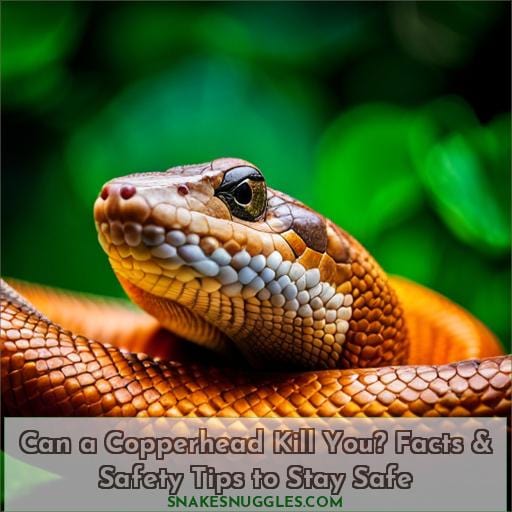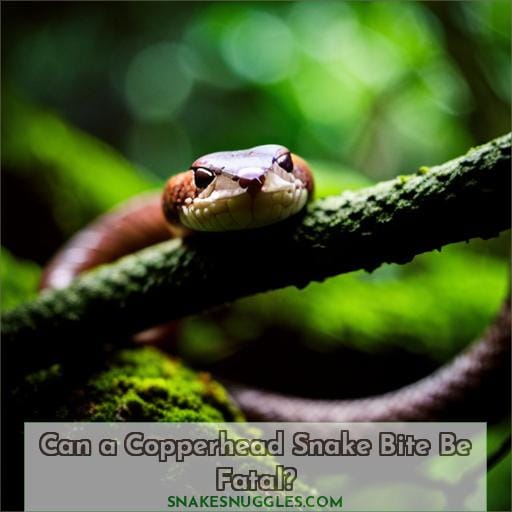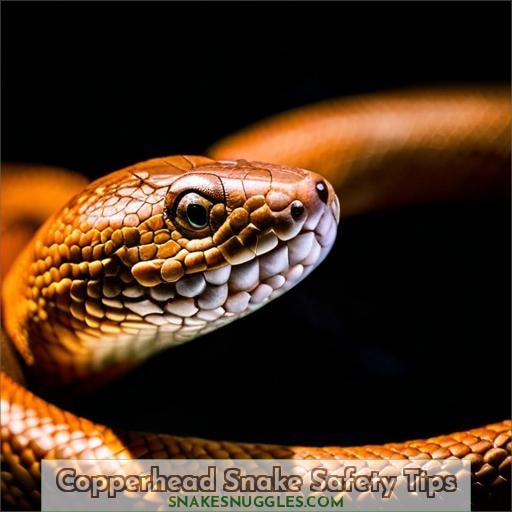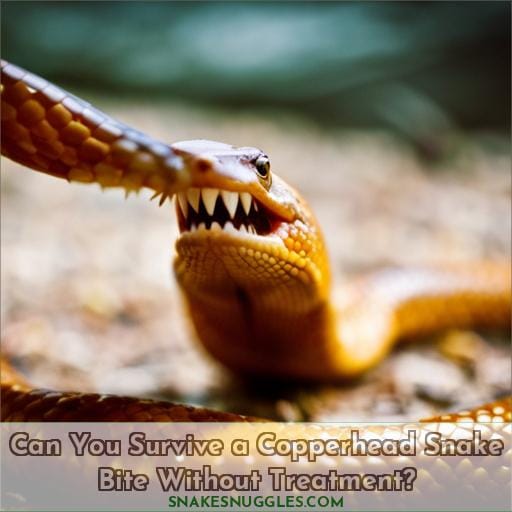This site is supported by our readers. We may earn a commission, at no cost to you, if you purchase through links.
 Surprised to find a copperhead in your garden? You’re not alone! As the most common venomous snake found in North America, copperheads send chills down many people’s spines. But how dangerous are they really? Can a Copperhead Kill You? We’ll answer that question and more as we explore facts about these creatures and offer safety tips to help you stay safe.
Surprised to find a copperhead in your garden? You’re not alone! As the most common venomous snake found in North America, copperheads send chills down many people’s spines. But how dangerous are they really? Can a Copperhead Kill You? We’ll answer that question and more as we explore facts about these creatures and offer safety tips to help you stay safe.
From understanding their bites to surviving without treatment, it’s time for all of us to get informed about this mysterious creature so we can protect ourselves from harm.
Table Of Contents
- Key Takeaways
- Can a Copperhead Snake Bite Be Fatal?
- Understanding Copperhead Snake Bites
- Copperhead Snake Safety Tips
- Can You Survive a Copperhead Snake Bite Without Treatment?
- How Dangerous Are Copperhead Snakes to Humans?
- The Threat of Copperhead Snakes to Dogs
- Frequently Asked Questions (FAQs)
- Conclusion
Key Takeaways
- Copperhead snakes are the most common venomous snake in North America.
- Their venom is hemotoxic and less potent than that of other venomous snakes.
- Bites from copperhead snakes can cause severe pain, tissue damage, swelling, and shock.
- While copperhead snake bites have a low mortality rate, immediate medical treatment is necessary to prevent complications and infection.
Can a Copperhead Snake Bite Be Fatal?
You may be surprised to learn that fatalities from copperhead snake bites are extremely rare. Though the venom of a copperhead is potent, it is still much less toxic than that of coral snakes and rattlesnakes.
Copperhead Snake Fatalities
With a venom toxicity much lower than other snakes like coral and rattlesnakes, the risk of death from a copperhead bite is very low.
The most dangerous aspect of these bites is their severity. Without proper treatment or for those with weaker immune systems, complications can arise, leading to even more serious symptoms such as shock and an irregular heartbeat.
To prevent being bitten in the first place, it’s important to be aware that copperheads inhabit many areas throughout eastern and central U.S., particularly wooded environments near water sources. Experts on venomous snakes, like pit vipers to which copperheads belong, recommend wearing long pants and closed-toe shoes when visiting such places.
Copperheads have LD50 ratings indicating that they are one of the least lethal forms of venomous snakes.
How Potent is Copperhead Venom?
You might be surprised to learn that copperhead venom is actually less potent than the venom of coral snakes and rattlesnakes, making it very unlikely for you to experience a fatal bite.
Here are some key facts about copperhead venom potency:
- Copperheads have heat-sensing pits in their heads, which help them detect prey before striking with their fangs.
- Despite this fact, there have been few recorded cases of fatalities due to a single bite from these snakes.
- To ensure your safety if encountered by one of these potentially dangerous reptiles, do not try to handle or kill it yourself. Instead, call a professional wildlife removal service right away and take necessary precautions such as wearing long pants and closed-toe shoes when visiting known habitats like wooded areas or rocky terrain near water sources where they commonly reside during nighttime activities.
Understanding Copperhead Snake Bites
If you encounter a copperhead snake, it is best to stay calm and move away immediately. Copperhead bites can cause severe symptoms in humans and even be fatal if left untreated, while dogs may suffer swelling, bleeding, or discharge from the venom.
It’s important to understand how to respond appropriately if bitten by a copperhead snake in order to protect yourself or your pets.
Symptoms and Treatment
If threatened, copperhead bites can cause severe pain, tissue damage, and an increased risk of infection without treatment. Copperhead venom toxicity is much lower than other pit vipers like rattlesnakes or coral snakes, so fatalities are rare.
Mild symptoms may be experienced, but serious complications such as allergic reactions require medical attention to prevent further injury or death. Symptoms range from weakness, swelling, and shock to an irregular heartbeat and numbness in the affected area, which could lead to more serious tissue damage if not treated properly with antivenom specific for a copperhead snake bite.
Copperhead Bite in Humans
When threatened, copperheads can strike fast and hard, leaving a painful double puncture wound that requires medical attention. Venom potency and bite symptoms vary with each individual. Treatment often involves reducing tissue damage risks and ensuring survival chances.
Copperhead snake behavior patterns are usually defensive rather than aggressive. If they feel threatened, they’ll try to hide first before striking in self-defense. If encountered, it’s best to leave them alone or call a professional wildlife removal service instead of trying to handle the snake yourself.
It is essential not only to seek medical assistance but also to provide information on the type of venomous snake involved. Hemotoxic venom from copperheads is far less potent than other species like rattlesnakes or coral snakes.
This will help guide proper antivenom selection for improved outcomes post-bite.
Copperhead Bite in Dogs
While copperhead bites are rarely fatal in humans, they can be extremely dangerous to man’s best friend: dogs. Even with prompt medical treatment, the venom from a copperhead bite can cause rapid swelling, bleeding, and discharge that may put a beloved pet at risk of death.
Venom potency varies based on the size and age of the snake, so it is important to assess the severity of the bite right away. To ensure snake safety for your pet, practice proper precautions such as avoiding wooded areas or long grass where snakes might hide and keeping pets leashed when outdoors.
If you think your dog has been bitten by a venomous snake, seek medical attention immediately. Notify the doctor of the type for proper antivenom treatment if needed, as well as call the National Poison Control Center (1-800-222-1222).
Anaphylactic reactions may occur in some cases, which could lead to fatality without proper immediate care, but these instances are rare even with high toxicity levels present within the venom itself.
Copperhead Snake Safety Tips
It is important to take necessary precautions when around copperhead snakes to ensure your safety. Copperheads are one of the most common venomous snakes in the United States and can be found throughout eastern and central regions from New England to Texas.
To avoid a negative reaction, it’s important that you remain aware of their habitat. Also, take certain steps for bite prevention, such as wearing long pants and closed-toe shoes. If you encounter a copperhead snake, it’s best not to go near or try handling them.
The potency of their hemolytic venom can result in severe symptoms if bitten without seeking medical advice immediately afterwards. So, understanding how serious these bites could be is essential for proper avoidance measures by those living within the range of this species’ territory.
Luckily, however, fatal cases due to copperhead bites are rare. There have only been a few recorded deaths over the past 90 years. This is because copperheads usually give warning bites before striking, which contain less venom than full strikes do.
This allows prey species more time for escape rather than the deadly consequences humans may face if left untreated.
Overall, taking precautionary steps when entering habitats with potential sightings, such as wooded areas where small rodents or frogs live, will greatly reduce risk. Stay alert at all times and avoid contact altogether. Just remember, when in doubt, don’t.
Can You Survive a Copperhead Snake Bite Without Treatment?
Surviving a copperhead snake bite without medical treatment can be difficult, but it’s not impossible. To avoid bites in the first place, knowing and understanding copperhead behavior is key.
These snakes are typically shy and non-aggressive, so if you see one, try to remain calm and move away slowly. Do not attempt to kill or handle the snake, as this can increase your chances of being bitten.
If you find yourself in an area with many copperheads around, it’s best to call a wildlife removal specialist for assistance rather than trying to remove them yourself.
If you unfortunately get bitten by a copperhead, seek help immediately. Even though their venom potency isn’t high compared with other venomous species like coral snakes or rattlesnakes, it still has the potential for severe symptoms that require medical attention.
These symptoms may include weakness, swelling, shock, irregular heartbeat, numbness, etc.
Depending on where your bite occurred, emergency room personnel may ask for pictures of the offending serpent before administering antivenom. So, having those ready will speed up treatment time. In more serious cases, doctors may need additional information such as how long ago you were bitten, when was your last meal eaten, and what type of clothing did you have on at the time.
Regardless, there are several options available for home care, such as taking ibuprofen, reducing swelling, wrapping the wound securely, elevating the limb, keeping hydrated, using cold compress, etc. Alternatively, you can seek professional help, which could include going directly to a doctor’s office, urgent care center, poison control hotline, or the emergency room, depending upon the severity.
Finally, remember that while rare, deaths directly from untreated copperhead bites have been recorded, mostly among children, elderly individuals, and immunocompromised adults. So, always take necessary precautions when venturing through areas known to be populated by these creatures.
How Dangerous Are Copperhead Snakes to Humans?
When it comes to copperhead snakes, avoiding bites is key. These venomous pit vipers are found in wooded and rocky areas from New England to Texas and typically measure 36-48 inches long with a weight of 1⁄2-3⁄4 pound.
In spite of their potency, the venom of copperheads is much weaker than that of rattlesnakes or coral snakes, making them less dangerous for humans overall.
Here are some tips to help you identify a copperhead snake:
- Look for its characteristic coppery red head.
- Note the hourglass pattern down its back.
- Check if they have heat sensing pits on each side near the nose area.
- Observe the vertical pupils in eyes which distinguish it from nonvenomous species.
- See if there’s a rattle at the end of the tail – only seen on Timber Rattlesnake but not Copperheads.
To prevent bites, take precautions when spending time outdoors by wearing long pants and closed-toe shoes, as well as being mindful of your surroundings – especially around water sources where these reptiles tend to be more active during night hours.
When confronted by one, never try handling or killing it – instead, stay calm and slowly move away while keeping an eye out for other nearby snakes since they often travel together in groups called ‘loafing’ sites!
Lastly, remember that although very rare (1 death per 50 million snake bite cases), fatalities can still occur due to their hemotoxic venom. Seek medical attention immediately upon getting bitten just in case you do experience any sudden severe symptoms like weakness, swelling, shock, irregular heartbeat, etc.
The Threat of Copperhead Snakes to Dogs
It’s important to be aware of the potential danger copperhead snakes pose to your pup, as their venom can be deadly for dogs. Copperheads are found throughout the eastern and central U.S., primarily in wooded or rocky areas near water sources.
This makes it essential that pet owners take proper precautions when walking their dog in these regions.
While not typically aggressive, copperheads may bite if provoked or threatened. They have heat-sensing pits which detect prey and a camouflaged pattern which helps them ambush unsuspecting animals like small rodents, frogs, lizards, insects, and crayfish.
The potency of a copperhead bite is much lower than other venomous snakes, such as coral snakes or rattlesnakes. However, dry bites with little venom still cause severe pain at the site of injection, along with tissue damage and the risk of infection.
It is important for pet owners to seek medical attention immediately upon detecting symptoms like weakness, swelling, shock, irregular heartbeat, numbness, etc.
Dog safety should always come first, so prevention techniques include wearing long pants and closed-toe shoes, avoiding grassy fields where wildlife removal services may need to be called depending on snake sightings, and keeping calm around any possible encounters.
Frequently Asked Questions (FAQs)
How far away should you stay from a copperhead snake?
To stay safe, maintain a safe distance from copperhead snakes. Respect their space and avoid provoking them. If you find one on your property, call a professional. If you encounter one in the wild, remain calm and slowly move away.
What are the long-term effects of a copperhead snake bite?
Stay away from copperheads – their bites can cause severe pain, tissue damage, and infection. Long-term effects include swelling, shock, numbness, and an irregular heart rate.
Are there any differences between male and female copperhead snakes?
Yes, there are differences between male and female copperhead snakes. Male copperheads tend to be larger than females and have a longer lifespan. Males also prefer drier habitats, while females may live in more marshes or wetlands.
Additionally, males may migrate further distances than their female counterparts during mating season for greater chances of finding mates.
Are copperhead snakes more active during the day or night?
Copperhead snakes are mostly nocturnal, active at night, and resting during the day. They typically live in wooded or rocky areas near water sources. Keep your distance if you encounter one; they will bite in self-defense if threatened or provoked.
How long can a copperhead snake live in captivity?
Copperhead snakes can live up to 15 years in captivity, provided they receive the right care and environment. They thrive with a warm shelter and plenty of food sources, such as small rodents, frogs, and insects.
Conclusion
Despite the fact that copperhead snake bites can be extremely painful and dangerous, the risk of death is extremely low. With prompt medical attention, the fatality rate from a copperhead bite is only 0.
This means that if you encounter a copperhead, there’s no need to panic. As long as you stay calm and follow safety tips such as wearing long pants and closed-toe shoes, the risk of being bitten is greatly reduced.
Taking the time to learn about copperhead bites and symptoms, as well as the treatment options, can help you stay safe and avoid the need for medical attention.












